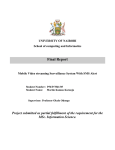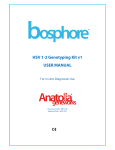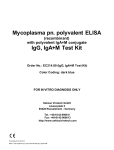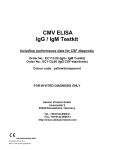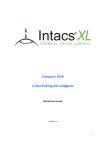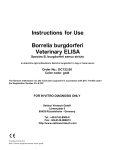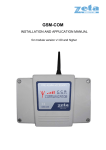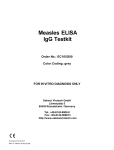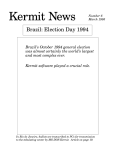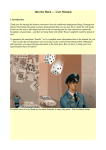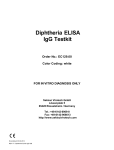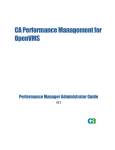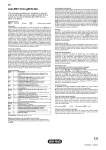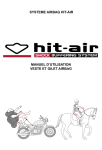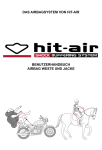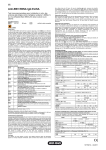Download Package Insert - Sekisui Diagnostics
Transcript
HSV 1 (gG1) ELISA (recombinant) HSV 2 (gG2) ELISA (affinity-purified) IgG / IgM Testkit Order No.: HSV 1 (gG1) EC130.00 HSV 2 (gG2) EC131.00 Color Coding: HSV 1 (gG1) red/black HSV 2 (gG2) red/dark blue FOR IN VITRO DIAGNOSIS ONLY Sekisui Virotech GmbH Löwenplatz 5 65428 Rüsselsheim / Germany Tel.: +49-6142-6909-0 Fax: +49-6142-966613 http://www.sekisuivirotech.com Druckdatum 03.02.2014 REV 13 / HSV 1 (gG1) / HSV 2 (gG2) ELISA IgG/IgM GB Contents 1. Intended Use ......................................................................................................................... 3 2. Diagnostic Relevance ............................................................................................................ 3 3. Test Principle......................................................................................................................... 4 4. Package Contents (IgG and IgM Testkit) ................................................................................ 4 5. Storage and Shelflife of the Testkit and the ready to use reagents ....................................... 4 6. Precautions and Warnings .................................................................................................... 5 7. Material required but not supplied......................................................................................... 5 8. Test Procedure ...................................................................................................................... 5 8.1 8.2 8.3 8.4 9. Examination Material....................................................................................................................................................... 5 Preparation of Reagents ................................................................................................................................................. 5 Virotech ELISA Test Procedure....................................................................................................................................... 6 Usage of ELISA processors ............................................................................................................................................ 6 Test Evaluation ...................................................................................................................... 6 9.1 9.2 9.3 9.4 Test function control........................................................................................................................................................ 6 Calculation of the Vir otech Units (VE) ............................................................................................................................. 7 Interpretation Scheme IgG and IgM ................................................................................................................................ 7 Limits of the Test............................................................................................................................................................. 7 10. Performance Data .................................................................................................................. 7 10.1 10.2 10.3 10.4 Analytic sensitivity and specif icity................................................................................................................................... 7 Prevalence (expected values) ......................................................................................................................................... 8 Intra-assay-Coefficient of Variation (Repeatability).......................................................................................................... 9 Inter-assay-Coefficient of Variation (Reproducibility)....................................................................................................... 9 11. Literature ............................................................................................................................... 9 12. Test Procedure Scheme ...................................................................................................... 11 Seite 2 v on 11 HSV 1 (gG1) / HSV 2 (gG2) ELISA IgG/IgM GB REV 13 Druckdatum 03.02.2014 1. Intended Use The HSV 1 (gG1) – resp. the HSV 2 (gG2) ELISA is intended for the semiquantitative and qualitative detection of specific IgG/IgM -antibodies against Herpes simplex Virus (HSV) type 1 resp. type 2 in human serum. The serology is suitable for the detection of the immune status and as Herpes exclusion. The use of the type -specific glycoproteins G, gG1 resp. gG2 enables the differentiation betw een HSV 1 and HSV 2 to determine the seroprevalence, to identify potential virus-carrier and for the risk calculation and prevention of the Herpes neonatorum. The IgM result must not be observed isolated from the IgG result. The diagnosis of the genital-herpes must be confirmed w ith the pathogen detection. The serology is not suitable for the detection of new -born Herpes, as the immune system of a baby is not completely developed at the date of its birth. How ever it can be used in retrospect to measure the transplacentally transferred anti-HSV2 IgG-antibodies. 2. Diagnostic Relevance Herpes simplex viruses are widely spread throughout the population. The transmitted results from direct contact w ith infected secretions from either a symptomatic or an asymptomatic host. Therefore the contamination starts already in the early childage. How ever these primary infections remain asymptomatical in over 90% of the cases, a latent infection is established in the regional ganglia as a rule. For the understanding of the pathogenesis of HSV -infection the fact that latent persistent viruses in the ganglia cells may be reactivated is of important meaning. The further spreading of the virus is favourabled by the asymptomatical virus expression throughout saliva and genital secretion. In the orafacial area the HSV1 -infections prevail, w hereas in the genital area the infections are mostly caused by HSV 2. Only a small part (5-30%) is generated by HSV 1 (11, 14). One of the most serious consequences of genital herpes is neonatal herpes ( 2). Without therapy, mortality for untreated infants w ho develop disseminated infection exceeds 70% with half of the survivors developing neurological impairment ( 14). Almost all neonate HSV 2 infections are acquired by passage through an infected birth canal ( 7). Most mothers (60-80%) w ho transmit HSV to their children are asymptomatic at delivery (14). Transmission rates are much higher w hen the mother is experiencing a primary or initial genital infection (50%) (14) versus a recurrent infection (<5%) (4, 5, 9). CDC recommends that „...prevention of neonatal herpes should emphasize the prevention of acquisition of genital HSV infection during late pregnancy. Susceptible women whose partners have oral or genital HSV infection, or those whose sex partners infection status is unknown, should be counseled to avoi d unprotected genital and oral sexual contact during late pregnancy“ (7). Viral isolation, direct fluorescent antibody (DFA) testing, and serology can be used to diagnose HSV infections. Disadvantages of the first tw o methods are how ever, length of culture time, specimen collection and transport difficulties, procedural complexity, and other variables that are associated w ith DFA and culture (1, 7). How ever, due to the significant cross-reactivity betw een HSV 1 and HSV 2, the serological assays, that use virus lysates as antigens, are not sufficiently suited to differentiate HSV 1 infections from HSV 2 infections. Due to the high contamination w ith HSV 1, the serological status for HSV 2 can be detected hardly reliable w ith such methods (14). Intrathecal IgG-antibodies occur only 8 – 10 days after the clinical symptoms in a present Herpes encephalitis. IgM antibodies are not regularly developed, but if so, it is in short term appearance and in very low concentration. This means t he serology can be used as a confirmatory tool of the clinical diagnosis retroactively. The genital HSV 1-infections recurrent considerably more rarely than HSV 2-infections. A previous infection w ith genital HSV1 seems to give a certain protection of infections w ith HSV 2 respectively allays the symptoms or entirely prevent them(10). A previous oral HSV 1 infection does not protect against a genital HSV 2 infection (14). The clinical picture of genital herpes corresponds those of other ulceration of the sexual organs and has theref ore to be differentiated against Haemophilus durcreyi, Treponema pallidum and Chlamydia trachomatis (7). Herpes simplex CSF diagnosis In contrast to the serological diagnosis of HSV infections, w hat is most important in CSF diagnosis is the reliable detection of endogenous synthesis of pathogen-specific antibodies in the CNS, rather than any differentiation betw een the pathogen species HSV-1 and HSV-2. As a result of the combination of highly purified HSV -1 and HSV-2 lysate antigens in the VT HSV Seite 3 v on 11 HSV 1 (gG1) / HSV 2 (gG2) ELISA IgG/IgM GB REV 13 Druckdatum 03.02.2014 screening test, this test system provides a very suitable screening test for the CSF diagnosis of HSV infections of the CNS, as it is highly sensitive. A broad spectrum of highly purified HSV antigens is used in the VT-HSV screen. This not only leads to the desired high sensitivity, but also to the equally desirable specificity w ith respect to differentiation from CNS infections w ith other neutrotropic pathogens of the herpes virus group. We therefore recommend that the antibody index (AI) should initially be determined in Herpes simplex diagnostic testing w ith the HSV Screen ELISA. If there is the additional aim of achieving differentiation betw een HSV1 and HSV2 after detection of an HSV -CNS infection, this can be achieved w ith the help of the tw o species-specific gG1 and gG2 ELISA tests. Limits: The level of pathogen-specific antibodies against the gG1 or gG2 epitopes in the CNS at the time w hen the CSF sample is taken may still (or already) be too low to increase the AI. Therefore, if the gG1 or gG2 test is performed alone this may give a false negative result in some cases or in specific cases, meaning that the antibody index is neither not calculable, or is normal. 3. Test Principle The antibody searched for in the human serum forms an immune complex w ith the antigen coated on the microtiter-plate. Unbound immunoglobulins are removed by w ashing processes. The enzyme conjugate attaches to this complex. Unbound conjugate is again removed by w ashing processes. After adding the substrate solution (TMB), a blue dye is produced by the bound enzyme (peroxidase). The color changes to yellow w hen the stopping solution is added. 4. Package Contents (IgG and IgM Testkit) 1. 2. 3. 4. 5. 6. 7. 8. 9. 10. 11. 12. 13. 5. 1 Microtiter-Plate consisting of 96 with antigen coated, breakable single w ells, lyophilised PBS-Dilution Buffer (blue, ready to use) 2x50m l, pH 7,2, w ith preservative and Tw een 20 PBS-Washing Solution (20x concentrated) 50m l, pH 7,2, w ith preservative and Tw een 20 IgG negative Control, 1300µl, human serum w ith protein-stabilizer and preservative, ready to use IgG cut-off Control, 1300µl, human serum w ith protein-stabilizer and preservative, ready to use IgG positive Control, 1300µl, human serum w ith protein-stabilizer and preservative, ready to use IgM negative Control, 1300µl, human serum w ith protein-stabilizer and preservative, ready to use IgM cut-off Control, 1300µl, human serum w ith protein-stabilizer and preservative, ready to use IgM positive Control, 1300µl, human serum w ith protein-stabilizer and preservative, ready to use IgG-Conjugate (anti-human), 11ml, (sheep or goat)-horseradish-peroxidase-conjugate with protein-stabilizer and preservative in Tris-Buffer, ready to use IgM-Conjugate (anti-human), 11ml, (sheep or goat)-horseradish-peroxidase-conjugate with FCS and preservative in Tris-Buffer, ready to use Tetramethylbenzidine substrate solution (3,3’,5,5’-TMB), 11m l, ready to use Citrate-Stopping Solution, 6m l, contains an acid mixture Storage and Shelflife of the Testkit and the ready to use reagents Store the testkit at 2-8°C. The shelf life of all components is show n on each respective label; for the kit shelf life please see Quality Control Certificate. 1. 2. 3. Microtiter strips/single w ells are to be resealed in package after taking out single w ells and stored w ith desiccant at 2-8°C. Reagents should immediately be returned to storage at 2-8°C after usage. The ready to use conjugate and the TMB-substrate solution are sensitive to light and have to be stored in dark. Should there be a color reaction of the substrate dilution due to incidence of light, it is not useable anymore. Take out only the amount of ready to use conjugate or TMB needed for the test insertion. Additional conjugate or TMB taken out may not be returned but must be dismissed. Material Test Samples Controls Status Diluted Undiluted After Opening Seite 4 v on 11 HSV 1 (gG1) / HSV 2 (gG2) ELISA IgG/IgM GB Storage +2 to +8°C +2 to +8°C +2 to +8°C Shelflife max. 6h 1 w eek 3 months REV 13 Druckdatum 03.02.2014 Microtitreplate After Opening Rheumatoid factor Absorbent Conjugate Tetramethylbenzidine Stop Solution Undiluted, After Opening Diluted After Opening After Opening After Opening After Opening Final Dilution (ready-to-use) Washing Solution 6. +2 to +8° (storage in the provided bag w ith desiccant bag) +2 to +8°C +2 to +8°C +2 to +8°C (protect from light) +2 to +8°C (protect from light) +2 to +8°C +2 to +8°C +2 to +25°C 3 months 3 months 1 w eek 3 months 3 months 3 months 3 months 4 w eeks Precautions and Warnings 1. 2. 3. 7. Only sera w hich have been tested and found to be negative for HIV -1 antibodies, HIV-2 antibodies, HCV antibodies and Hepatitis-B surface-antigen are used as control sera. Nevertheless, samples, diluted samples, controls, conjugates and microtiter strips should be treated as potentially infectious material. Please handle products in accordance with laboratory directions. Those components that contain preservatives, the Citrate Stopping Solution and the TMB have an irritating effect to skin, eyes and mucous. If body parts are contacted, immediately w ash them under flow ing water and possibly consult a doctor. The disposal of the used materials has to be done according to the country-specific guidelines. Material required but not supplied 1. 2. 3. 4. 5. 6. 7. 8. 9. 10. 8. Aqua dest./demin. Eight-channel pipette 50µl, 100µl Micropipettes: 10µl, 100µl, 1000µl Test tubes Paper tow els or absorbent paper Cover for ELISA-plates Disposal box for infectious material ELISA handw asher or automated EIA plate w ashing device ELISA plate spectrophotometer, w avelength = 450nm, reference length = 620nm (Reference Wavelength 620-690nm) Incubator Test Procedure Working exactly referring to the Sekisui Virotech user manual is the prerequisite for obtaining correct results. 8.1 Examination Material Either serum or plasma can be used as test material, even if only serum is mentioned in the instructions. Any type of anticoagulant can be used for plasma. Alw ays prepare patient-dilution freshly. For a longer storage the sera must be frozen. Repeated defrosting should be avoided. 1. Only fresh non-inactivated sera should be used. 2. Hyperlipaemic, haemolytic, microbially contaminated and turbid sera should not to be used (false positive/negative results). 8.2 Preparation of Reagents The Sekisui Virotech System Diagnostica offers a high degree of flexibility regarding the possibility to use the dilution buffer, w ashing solution, TMB, citrate stopping solution as w ell as the conjugate for all parameters and for all different lots. The ready to use controls (positive control, negative control, cut-off control) are param eter specific and only to use w ith the plate lot indicated in the Quality Control Certificate. 1. 2. 3. Set incubator to 37°C and check proper temperature setting before start of incubation. Bring all reagents to room temperature before opening package of microtiter strips. Shake all liquid components w ell before use. Seite 5 v on 11 HSV 1 (gG1) / HSV 2 (gG2) ELISA IgG/IgM GB REV 13 Druckdatum 03.02.2014 4. 5. Make up the w ashing solution concentrate to 1 L w ith distilled or demineralised w ater. If crystals have formed in the concentrate, please bring the concentrate to room temperature before use and shake w ell before use. High IgG-titer or rheumatoid factors may disturb the specific detection of IgM-antibodies and may lead to false positive resp. false negative results. For a correct IgM-determination it is therefore necessary to pre-treat the sera with RFSorboTech (VIROTECH adsorbent). For IgM-controls a pre-absorbent treatment is not necessary. 8.3 Virotech ELISA Test Procedure 1. 2. 3. 4. 5. 6. 7. 8. 9. 10. For each test run, pipette 100µl each of ready to use dilution buffer (blank), IgG- and IgM-positive, negative and cut-off controls as w ell as diluted patient sera. We propose a double insertion (blank, controls and patient sera); for cut-off control a double insertion is absolutely necessary. Working dilution of patient sera: 1+100; e.g. 10µl serum + 1ml dilution buffer. After pipetting start incubation for 30 min. at 37°C (w ith cover). End incubation period by w ashing microtiter strips 4 times w ith 350 – 400µl w ashing solution per w ell. Do not leave any w ashing solution in the w ells. Remove residues on a cellulose pad. Pipette 100µl of ready to use conjugate into each w ell. Incubation of conjugates: 30 min. at 37°C (w ith cover). Stop conjugate incubation by w ashing 4 times (pls. refer to point 3 above). Pipette 100µl of ready to use TMB into each w ell. Incubation of substrate solution: 30 min. at 37°C (w ith cover, keep in dark). Stopping of substrate reaction: pipette 50µl of citrate stopping solution into each w ell. Shake plate carefully and thoroughly until liquid is completely mixed and a homogeneous yellow color is visible. Measure extinction (OD) at 450/620nm (Reference Wavelength 620-690nm). Set your photometer in such a w ay that the blank value is deducted from all other extinctions. Extinctions should be measured w ithin 1 hour after adding the stopping solution! Pls. refer to last page for Test Procedure Scheme 8.4 Usage of ELISA processors All Sekisui Virotech ELISAs can be used on ELISA processors. The user is bound to proceed a validation of the devices (processors) on a regular basis. Sekisui Virotech recommends the follow ing procedure: 1. Sekisui Virotech recommends to proceed the validation of device referring to the instructions of the device manufacturer during the implementation of the ELISA processor respectively after bigger reparations. 2. It is recommended to check the ELISA-processor w ith the Validationkit (EC250.00) afterw ards. A regular check using the Validationkit shall be proceeded minimum once a quarter to test the accuracy of the processor. 3. The release criteria of the Quality Control Certificate of the product must be fulfilled for each testrun. With this procedure, your ELISA processor w ill function properly and this w ill support quality assurance in your laboratory. 9. Test Evaluation The ready to use controls serve for a semiquantitative determination of specific IgG- and IgM-antibodies. Their concentration can be expressed in Virotech units = VE. Fluctuations resulting from the test procedure can be balanced w ith this calculation method and a high reproducibility is achieved in this w ay. Use the means of the OD values for calculation of the VE. 9.1 Test function control a) OD-values The OD of the blank should be < 0.15. The OD-values of the negative controls should be low er than the OD-values mentioned in the Quality Control Certificate. The OD-values of the positive controls as w ell as of the cut-off controls should be above the OD-values mentioned in the Quality Control Certificate. b) Virotech Units (VE) The Virotech Units (VE) of the cut-off controls are defined as 10 VE. The calculated VE of the positive controls should be w ithin the ranges mentioned in the Quality Control Certificate. Seite 6 v on 11 HSV 1 (gG1) / HSV 2 (gG2) ELISA IgG/IgM GB REV 13 Druckdatum 03.02.2014 If those requirements (OD-values, VE) are not fulfilled, the test has to be repeated. 9.2 Calculation of the Virotech Units (VE) The extinction of the blank value (450/620nm) has to be subtracted from all other extinctions. OD (positive control) x 10 OD (cut-off control) OD (patient serum) x 10 OD (cut-off control) VE (positive control) VE (patient serum) 9.3 Interpretation Scheme IgG and IgM Result (VE) < 9,0 9,0 - 11,0 > 11,0 1. 2. 3. 4. Evaluation negative borderline positive If the measured values are above the defined borderline range, they are considered to be positive. If the measured VE is w ithin the borderline range, no significant high antibody concentration is present, the s amples are considered to be borderline. For the secure detection of an infection it is necessary to determine the antibody concentration of tw o serum samples. One sample shall be taken directly at the beginning of the infection and a second sample 5 – 10 days later (convalescent serum). The antibody concentration of both samples has to be tested in parallel, that means in one test run. A correct diagnosis based on the evaluation of a single serum sample is not possible. If the measured values are below the defined borderline range, no measurable antigen specific antibodies are present in the samples. The samples are considered to be negative. In case of a positive IgM result a review of the result by observing the course of the IgG titer is recommended. 9.4 Limits of the Test 6. 7. The interpretation of serological results shall alw ays include the clinical picture, epidemiological data and all further available laboratory results. Despite all advantages of the gG2-assay there exist also notes tow ards the limits of the test: On one hand the therapy w ith Acyclovirdie may influence the antibody development (3) and on the other hand, the genetic variability of the gG2 protein may lead to gG2 negative HSV 2 strains. 10. Performance Data 10.1 Analytic sensitivity and specificity HSV 1 (gG1) 325 sera have been tested in IgG and compared w ith an Immunoblot able to differenciate (gG1 and gG2 specific) gG1 HSV 1-specific ELISA Virotech n=325 Analytic Finding HSV 1 and HSV 2 Immunoblot IgG (able to differenciate) HSV 1 negative negative 88 positive 1 HSV 1 positive 3 206 27 sera show ing borderline results w ith the reference system or the ELISA have not been considered. Thus, an analytic sensitivity of 98,6% and an analytic specificity of 98,9% have been calculated. Seite 7 v on 11 HSV 1 (gG1) / HSV 2 (gG2) ELISA IgG/IgM GB REV 13 Druckdatum 03.02.2014 HSV 2 (gG2) 346 sera have been tested in IgG and compared w ith an Immunoblot able to differenciate (gG1 and gG2 specific) gG2 HSV 2-specific ELISA Virotech negative positive n=346 Analytic Finding HSV 1 and HSV 2 Immunoblot IgG (able to differenciate) HSV 2 negative 199 2 HSV 2 positive 3 124 18 sera show ing borderline results w ith the reference system or the ELISA have not been considered. Thus, an analytic sensitivity of 97,6% and an analytic specificity of 99,0% have been calculated. 10.2 Prevalence (expected values) HSV 1 (gG1) IgG The follow ing table show s the results obtained w ith the Sekisui Virotech ELISA for selected sera collectives. The epidemiological data described in the literature are listed in comparison. Sera Collective positive with the VT ELISA in % Literature Statement Blood donors (n= 120) 71,7% Infant sera (n=39) 33,3% Prostitutes sera (n=39) 82,1% 30% : 1-5 year old 50% : 12-16 year old (12) - Crossreactive sera (n=39) 51,3% - 80% in Germany (15) 75% in Germany (10) 80% in Sw itzerland (6) Pregnant w omen´s-sera (n=51) 72,5% 70% in Netherlands (13) Potentially cross-reactive sera (EBV, VZV, Measles, Parvo, CMV) and sera of pregnant w omen do not show an increased percentage of positive sera compared to the blood donors. This confirms the excellent specificity of the assays. HSV 1 (gG1) IgM The follow ing table show s the results obtained w ith the Sekisui Virotech ELISA for selected sera collectives: Sera Collective Positive with the VT ELISA in % Blood donors (n= 120) Infant sera (n=40) 0 0 Prostitutes sera (n=40) 0 Pregnant w omen´s sera (n=52) Crossreactive sera (n=40) 0 5 HSV 2 (gG2) IgG The follow ing table show s the results obtained w ith the Sekisui Virotech ELISA for selected sera collectives. The epidemiological data described in the literature are listed in comparison. Sera Collective Seite 8 v on 11 HSV 1 (gG1) / HSV 2 (gG2) ELISA IgG/IgM GB positive with the VT Literature Statements REV 13 Druckdatum 03.02.2014 ELISA in % 15% in Germany (15) 14-18% in Germany (10) 19% in Sw itzerland (6) Blood donors (n= 120) 7,5% Infants sera (n=39) 0% Prostitutes sera (n=39) 69,2% Crossreactive sera (n=39) 7,7% 78% in Germany (10) 49% in Sw itzerland (8) - Pregnant w omen´s sera (n=51) 5,9% - 1-5 year old< 2% 6-11 year old < 3% 11-16 year old approx.8% (12) Potentially cross-reactive sera (EBV, VZV, Measles, Parvo, CMV) show an identical percentage of positive sera compared to blood donors sera. Sera of pregnant w omen show a low er percentage of positive sera compared to blood donors sera. This confirms the excellent specificity of the assays. HSV 2 (gG2) IgM The follow ing table show s the results obtained w ith the Sekisui Virotech ELISA for selected sera collectives. Sera Collective Positive with the VT ELISA Blood donors (n= 120) 1,7 % Infants sera (n=40) Prostitutes sera (n=40) 0% 0% Pregnant w omen´s sera (n=52) 0% Crossreactive sera (n=40) 0% 10.3 Intra-assay-Coefficient of Variation (Repeatability) In one assay, strips of different plates of one batch have been tested in a chessboard pattern w ith tw o sera. The obtained coefficients of variation for IgG for HSV 1 (gG1) and HSV 2 (gG2) are < 15%. 10.4 Inter-assay-Coefficient of Variation (Reproducibility) Three sera w ere tested in 10 independent test runs on three different testdays. The obtained variation coefficient values for HSV 1 (gG1) and HSV 2 (gG2) are <15%. 11. Literature 1. 2. 3. 4. 5. 6. 7. Anzivino, E, D Fioriti, M Mischitelli, A Bellizzi, V Barucca, F Chiarini, V Pietropaolo. 2009. Herpes simplex virus infection in pregnancy and in neonate: status of art of epidemiology, diagnosis, therapy and prevention. Virol J. 6,40 Arvin, A, C Prober. 1995. Herpes Simplex Viruses. 876-883. In Murray, P, E Baron, M Pfaller, F Tenover, and R Yolkenet (eds.). Manual of Clinical Microbiology. 6th Ed. ASM, Washington, D.C. Bernstein, DI, LR Stanberry, CJ Harrison, JC Kappes, MG Myers. 1986. Antibody response, recurrence patterns and subsequent herpes simplex virus type 2 (HSV -2) re-infection following initial HSV-2 infection of guinea-pigs: effects of acyclovir. J Gen Virol. 67, 1601-1612 Brow n ZA, Benedetti J, Ashley R, Burchett S, Selke S, Berry S, Vontver LA, Corey L.. 1991.Neonatal herpes simplex virus infection in relation to asymptomatic maternal infection at the time of labor. N Engl J Med. 324, 1247-1252 Brow n, Z , S Sleke, J Zeh, J Kopelmann, A Maslow , R Ashley, D Watts, S Berry, M Herd, L Correy. 1997. The acquisition of herpes simplex virus during pregnancy. N Engl J Med. 337, 509-515 Bünzli, D, Wietlisbach V, Barazzoni F, Sahli R, Meylan PR. 2004. Seroepidemiology of Herpes Simplex virus type 1 and 2 in Western and Southern Sw itzerland in adults aged 25–74 in 1992–93 : a population-based study. BMC Infect Dis. 4. http://www.biomedcentral.com/1471-2334/4/10 CDC. 1998. Guidelines for Treatment of Sexually Transmitted Diseases. MMWR. 47, 1-118 Seite 9 v on 11 HSV 1 (gG1) / HSV 2 (gG2) ELISA IgG/IgM GB REV 13 Druckdatum 03.02.2014 8. 9. 10. 11. 12. 13. 14. 15. Eing, BR Lippelt L, Lorentzen EU, Hafezi W, Schlumberger W, Steinhagen K, Kühn JE. 2002. Evaluation of confirmatory strategies for detection of type-specific antibodies against herpes simplex virus type 2. J Clin Microbiol. 40, 407-413. Prober, C, W Sullender, L Yasukawa, D Au, A Yaeger, A Arvin. 1987. Low risk if herpes simplex virus infections in neonates exposed to the virus at the time of vaginal delivery to mothers w ith recurrent herpes simplex virus infections. N Engl J Med. 316, 240-244 Rabenau HF, Buxbaum S, Preiser W, Weber B, Doerr HW. 2002. Seroprevalence of herpes simplex virus types 1 and type 2 in the Frankfurt am Main area, Germany. Med Microbiol Immunol. 190, 153-160 Roizman, B, DM Knipe. 2001. Herpes Simplex Viruses and Their Replication. . In Fields, B, D Knipe, P How ley, et al. (eds.). Fields Virology 4th Ed. Lippincott-Raven, Philadelphia Smith J, N Robinson. 2002, Age-specific prevalence of infection with herpes simplex : a global review . J Inf Dis. 186, 3-28 Tunbäck, P, Bergström T, Claesson BA, Carlsson RM, Löw hagen GB. 2007. Early acquisition of herpes simplex virus type 1 antibodies in children-A longitudinal serological study. J Clin Vir. 40, 26-30 Whitley, R. 2001. Herpes Simplex Viruses. In Fields, B, D Knipe, P How ley, et al. (eds.). Fields Virology 4th Ed. LippincottRaven, Philadelphia Wutzler, P, Doerr HW, Färber I, Eichhorn U, Helbig B, Sauerbrei A, Brandstädt A, Rabenau HF. 2000. Seroprevalence of herpes simplex virus type 1 and type 2 in selected German populations - relevance for the incidence of genital herpes. J Med Virol. 61, 201-207 Seite 10 v on 11 HSV 1 (gG1) / HSV 2 (gG2) ELISA IgG/IgM GB REV 13 Druckdatum 03.02.2014 12. Test Procedure Scheme Preparation of Patient Samples and Washing Solution ▼ Washing Solution: Fill up concentrate ▼ IgG-Samples – Dilution 1:101 e.g.: 10 µl serum/plasma + 1000 µl Dilution Buffer (Serum Dilution Buffer is ready to use) to 1 liter with aqua dest./demin. ▼ IgM-Samples - Dilution 1:101 Rheumafactor-absorption with RFSorboTech e.g.: 5 µl serum/plasma + 450 µl Dilution Buffer + 1 drop RF-SorboTech, incubate for 15 min. at room temperature. Testprocedure Samples Incubation 30 minutes at 37°C 100 µl Patient Samples blank value (Dilution Buffer) and controls 400 µl Washing Solution Wash 4times Remove Residues on a Cellulose Pad Conjugate Incubation 30 minutes at 37°C 100 µl Conjugate IgG, IgM 400 µl Washing Solution Wash 4times Remove Residues on a Cellulose Pad Substrate Incubation 30 minutes at 37°C Stopping 100 µl Substrate 50 µl Stopping Solution shake carefully Measure Extinctions Seite 11 v on 11 HSV 1 (gG1) / HSV 2 (gG2) ELISA IgG/IgM GB Photometer at 450/620nm (Reference Wavelength 620690nm) REV 13 Druckdatum 03.02.2014













